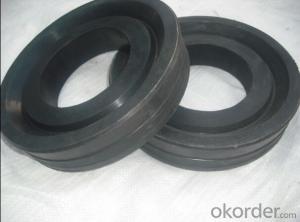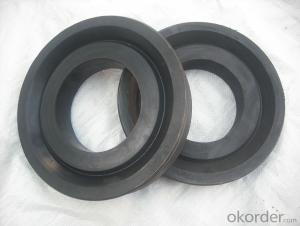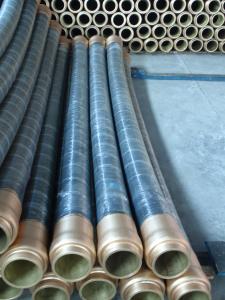SANY RUBBER PISTON DN200 WITH FIBER HIGH QUALITY
- Loading Port:
- Tianjin
- Payment Terms:
- TT OR LC
- Min Order Qty:
- 1 set
- Supply Capability:
- 500 set/month
OKorder Service Pledge
OKorder Financial Service
You Might Also Like
Sany oncrete pump rubber pistonwith fiber DN200
Schwing/ Sany/PM/Zoomlion concrete pump rubber piston
name | Concrete pump piston |
size | DN200 for Schwing DN230 for Schwing DN200 for PM entirety piston DN230 for PM entirety piston DN180 for Zoomlion piston DN200 for Zoomlion piston DN220 for Zoomlion piston DN230 for Zoomlion piston DN180 for Sany piston DN195 for Sany piston DN200 for Sany piston DN230 for Sany piston DN260 for Sany piston DN280 for Sany piston Other sizes and types upon request |
Material | PUR Polyurethane,natural rubber |
Applacation | Used in concrete pump truck,concrete pump,Hydrulic ram system in Construction work equipment
|
Serving brands of mounted truck concrete pump and concrete pump | Sany ,PM, Zoomlion,Schwing,CIFA and so on |

- Q: What is the role of a concrete pump agitator shaft seal?
- The role of a concrete pump agitator shaft seal is to prevent any leakage or seepage of materials, such as concrete or grout, from the agitator shaft. It is designed to create a tight seal between the rotating shaft and the stationary housing, ensuring that no material escapes from the pump during operation. This is crucial in maintaining the efficiency and effectiveness of the concrete pump by preventing any loss of material. The seal also helps to protect the agitator shaft from any external contaminants, such as dirt or water, which could potentially damage the pump. Overall, the concrete pump agitator shaft seal plays a vital role in ensuring the smooth and reliable operation of the pump, while also maintaining the quality of the pumped materials.
- Q: Can concrete pump spare parts be retrofitted to older pump models?
- Indeed, older pump models can often accommodate retrofitting of concrete pump spare parts. Multiple manufacturers engineer their spare parts to be compatible with various pump models, even those from previous generations. Nonetheless, it is crucial to acknowledge that not all spare parts may be appropriate for retrofitting, as compatibility can differ based on the specific pump model and the part in consideration. It is advisable to seek guidance from the manufacturer or a qualified technician to ascertain the compatibility and safe retrofitting of the spare parts onto older pump models.
- Q: What is the purpose of a concrete pump wear plate?
- The purpose of a concrete pump wear plate is to protect the essential components of a concrete pump, such as the housing and the rotor, from excessive wear and tear caused by the abrasive nature of concrete. It acts as a sacrificial layer, absorbing the impact and friction of the concrete, thereby extending the lifespan of the pump and reducing maintenance costs.
- Q: Are there any warranties or guarantees available for concrete pump spare parts?
- Concrete pump spare parts come with warranties and guarantees to ensure their quality and performance. Various manufacturers and suppliers provide these warranties, which typically cover defects in materials or workmanship. The coverage period usually ranges from a few months to a year or more. Furthermore, some suppliers offer guarantees on the performance or durability of their spare parts, providing customers with reassurance. To ensure your protection in case of any issues, it is advisable to inquire about the specific warranty or guarantee terms before purchasing concrete pump spare parts.
- Q: What do these types of concrete pumps mean?
- After the 16 is the motor power kW (landlord 16 seems to have a mistake, usually 110) or the manufacturer's serial number.
- Q: Can concrete pump spare parts be tested for performance and quality before installation?
- Yes, concrete pump spare parts can be tested for performance and quality before installation. This is typically done to ensure that the parts meet the required specifications and standards, reducing the risk of any potential issues or failures during operation. Testing can involve various methods such as performance testing, stress testing, durability testing, and quality control checks to ensure optimal performance and reliability of the spare parts.
- Q: What are the elements of concrete pump and concrete pump truck selection?
- The performance of the random type varies depending on the type and structure of concrete pump truck building, in addition to considering the choice of models into the concrete pouring amount, should also consider the building type and structure, technical requirements, construction site conditions and environment etc.. The main performance parameters of the concrete pump vehicle should be in line with the construction requirements or slightly larger. If the capacity is too large, the utilization rate is low, too small, not only can not meet the requirements, but also will accelerate the loss of the concrete pump truck.
- Q: How often should concrete pump electric motors be inspected and maintained?
- Concrete pump electric motors should be inspected and maintained regularly to ensure their optimal performance and longevity. It is recommended to have them inspected at least once a year or every 500-1000 operating hours, whichever comes first. Additionally, regular maintenance should be carried out based on the manufacturer's guidelines and recommendations. This may include checking and replacing worn-out parts, lubricating moving components, cleaning dust and debris, and inspecting electrical connections for any signs of damage or loose connections. Adhering to a regular inspection and maintenance schedule will help prevent potential breakdowns, increase the lifespan of the motor, and ensure the concrete pump operates efficiently.
- Q: Are there any specific safety precautions for handling concrete pump spare parts?
- Yes, there are specific safety precautions that should be followed when handling concrete pump spare parts. Firstly, it is important to wear appropriate personal protective equipment (PPE) such as gloves, safety goggles, and a dust mask to protect against any potential hazards. Concrete dust can be harmful if inhaled or comes into contact with the skin, so it is important to take necessary precautions. When handling concrete pump spare parts, it is crucial to ensure proper lifting techniques are used to avoid strains or injuries. Heavy parts should be lifted with the help of lifting equipment or with the assistance of others to minimize the risk of accidents. Additionally, it is important to handle the spare parts with care and avoid any rough handling or dropping, as this can lead to damage or breakage. Damaged spare parts can affect the overall performance and safety of the concrete pump. Furthermore, it is recommended to store the spare parts in a clean and dry area, away from any moisture or chemicals that could potentially damage them. Proper storage will help maintain the quality and integrity of the spare parts. Lastly, it is always advised to follow the manufacturer's instructions and guidelines when handling concrete pump spare parts. They often provide specific safety precautions and recommendations that should be followed to ensure the safe handling and use of the parts. By following these safety precautions, the risk of accidents, injuries, and damage to the concrete pump spare parts can be minimized, ensuring a safe working environment.
- Q: How does a concrete pump clamp work?
- A concrete pump clamp is an essential component of a concrete pump that is used to secure and hold the concrete delivery pipeline in place. It works by tightly gripping the pipeline to prevent any movement or leaks during the concrete pumping process. Typically, a concrete pump clamp consists of two main parts: the clamp body and the wedge. The clamp body is usually made of durable steel and has a curved shape that is designed to fit around the pipeline. It is equipped with bolts or knobs that can be tightened or loosened to secure the clamp onto the pipeline. The wedge, on the other hand, is a piece of metal that is inserted into the clamp body. It is responsible for exerting pressure onto the pipeline when the clamp is tightened. By turning the bolts or knobs, the wedge is pushed further into the clamp body, causing it to squeeze the pipeline tightly and create a firm grip. The tight grip created by the concrete pump clamp is crucial as it ensures that there are no leaks or disruptions in the concrete flow. It helps to maintain a consistent and steady flow of concrete from the pump to the desired location. Additionally, the clamp also provides stability to the pipeline, preventing it from moving or shifting during the pumping process. Overall, a concrete pump clamp plays a vital role in the efficient and safe operation of a concrete pump. It ensures that the concrete delivery pipeline remains securely in place, allowing for a smooth and uninterrupted concrete pumping process.
Send your message to us
SANY RUBBER PISTON DN200 WITH FIBER HIGH QUALITY
- Loading Port:
- Tianjin
- Payment Terms:
- TT OR LC
- Min Order Qty:
- 1 set
- Supply Capability:
- 500 set/month
OKorder Service Pledge
OKorder Financial Service
Similar products
Hot products
Hot Searches
Related keywords
























